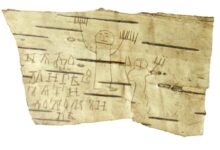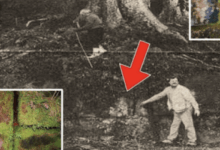Archeologists Opened an Egyptian Mummy Tomb After 4,400 years, What They Found SHOCKED The World!
For centuries, archaeologists believed they had uncovered most of ancient Egypt’s secrets—grand pyramids, majestic pharaohs, and treasures buried deep beneath the endless desert sands. However, hidden beneath the ever-shifting dunes of Saqqara lay a tomb sealed for over 4,400 years, untouched and silent, waiting patiently to reveal its mysteries. When a team of dedicated archaeologists finally pried open the narrow shaft descending nearly forty feet below the surface, they uncovered far more than mere bones or rubble. They discovered a monumental false door carved from rare pink granite, towering over fourteen feet tall.
This false door was far from decorative; it served a sacred spiritual purpose in ancient Egyptian belief. It functioned as a portal, allowing the soul of the deceased to traverse between the world of the living and the realm of the dead. Inscribed on this magnificent stone was the name of Prince Userefre—a forgotten son of Pharaoh Userkaf from Egypt’s Fifth Dynasty—whose existence had long eluded historians, statues, and papyri alike until this extraordinary discovery.
The grandeur of the door and the choice of pink granite, quarried from a distant location over 400 miles away, emphasized the prince’s royal status and immense prestige. Alongside the door, archaeologists found a finely crafted offering table made of red granite, positioned to receive offerings intended to nourish the prince’s spirit in the afterlife.
This tomb’s discovery challenges established historical timelines and provides crucial new insights into a politically complex era—one when Egypt was transitioning from a centralized monarchy toward a more fragmented, regionalized power structure. Adding to the intrigue, within the tomb, archaeologists uncovered a rare and puzzling statue of Pharaoh Djoser from the Third Dynasty. The statue depicted the king alongside his family, raising profound questions about dynastic continuity and religious symbolism. Particularly curious was the evidence that the tomb had been reused nearly two thousand years later, during Egypt’s Twenty-Sixth Dynasty.
Nearby, sealed coffins from these later periods were also uncovered, perfectly preserved and famously opened in a live broadcast event. These coffins offered unprecedented glimpses into ancient Egyptian funerary practices, shedding light on rituals surrounding life, death, and the afterlife. Yet despite these remarkable finds, much of Prince Userefre’s burial chamber remains unexplored, holding the promise of further revelations that could dramatically reshape our understanding of ancient Egypt.
As debates surrounding the ethics of excavation and preservation grow increasingly intense, the pink granite false door remains not only a monument to a forgotten prince but also a symbolic gateway. It stands as a portal to the deepest secrets of Saqqara—secrets that may forever alter how we view the ancient world and its eternal mysteries.
In 2020, when archaeologists opened one of the ancient coffins from Saqqara live on stage, the event unfolded almost like a dramatic theatrical performance. But what they revealed was truly extraordinary. Inside the wooden coffin, untouched for over two thousand years, lay a remarkably well-preserved mummy. Unlike the fragile, dusty skeletons often expected, this body was wrapped in linen that still shimmered with vibrant colors, adorned with sacred hieroglyphs, and appeared as though it had been laid to rest only recently.
The pristine condition stunned experts: the wrappings were immaculate, facial features still clearly defined, and a faint aroma of ancient resins lingered on the cloth. This was not merely an artifact but a person—preserved with embalming techniques so advanced that even modern science struggles to replicate them. The atmosphere in the room shifted from excitement to reverent awe as a live X-ray scan revealed the individual’s approximate age—between 40 and 45 years old—standing about five feet seven inches tall. There were no signs of injury or disease; the body was that of a healthy adult who had been carefully embalmed with natron and resin to resist decay. His arms were folded across his chest, a traditional symbol of status, surrounded by ritual objects meant to guide his journey into eternity.
Later that same year, another coffin was opened near the Step Pyramid of Djoser, revealing an individual of even higher status. This person was adorned with gold leaf, embedded stones, and symbols that denoted priestly power and influence. Alongside the human remains, archaeologists found mummified animals—including rare lion cubs—hinting at the spiritual guardianship and elite privileges accorded in the afterlife.
These discoveries captivated the world, blending history with a tangible sense of living memory. However, they also sparked intense ethical debates about disturbing sacred tombs. While many welcomed the insights into ancient Egyptian society and the revival of tourism, others urged for respect and reburial, fearing the loss of spiritual significance inherent in these sacred resting places.
As excavations progressed, an even deeper mystery emerged within the tomb of Prince Userefre. His burial chamber defied all expectations. There was no sarcophagus, no human remains—only a strange vault coated in soot, inscribed with unknown symbols and filled with an enigmatic scent. The tomb’s layout was deliberately confusing, featuring looping chambers and sand-filled traps designed to mislead intruders and protect its secrets.
The atmosphere at the site grew tense as strange occurrences plagued the excavation team—unexplained electromagnetic disturbances and shadowy figures unsettled the researchers. Government security quietly intervened, restricting access and summoning specialists to decode the mysterious inscriptions. These symbols bore no resemblance to known Egyptian rituals; instead, they echoed cosmic maps found in Babylonian and Mesoamerican cultures.
This suggests that the prince’s tomb was more than a burial site—it might have been a sealed portal or trap meant to contain a powerful, unknown force. The discovery challenges everything we thought we knew about ancient Egypt, hinting at secret knowledge of the afterlife as a physical realm and an ancient quest to control what lies beyond death.




